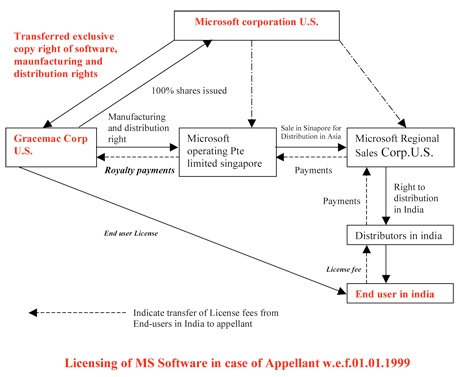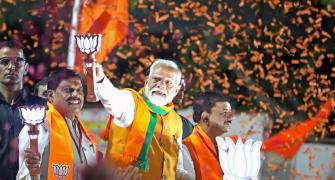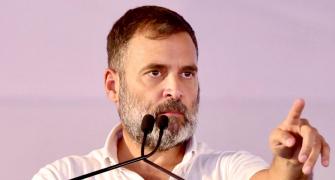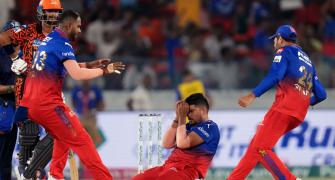If a survey is conducted in India with the sole objective of finding a non-user of Microsoft software, the exercise may not yield tangible results at all. In other words, no computer literate can even feign ignorance about his familiarity with Microsoft products. So pervasive and entrenched are the Microsoft brand name and products in any computer-literate society.
Microsoft pays income tax on income generated from its software licensing in all other countries in the world. But not many know that the Microsoft Corporation does not contribute even a single penny to the Indian exchequer in terms of income tax!
Against this backdrop, TIOL (www.taxindiaonline.com) has come to know that in a path-breaking judicial decision, the CIT(A) -- Commissioner of Income Tax (Appeals) -- handling international taxation cases in Delhi has recently held that the Gracemac Corporation, a 100% subsidiary of Microsoft which had in 1999 granted proprietary and ownership right in license and in intellectual property (IPR) of Microsoft software and hardware products, is liable to pay income tax on its gross royalty income earned out of licensing of software to Indian customers.
The total gross royalty income for the six assessment years -- from 1999 to 2005 -- is computed to be about Rs 2,240 crore (Rs 22.40 billion). Going by 15% tax on royalty u/s 9(1)(vi) of the Income Tax Act read with Article 12 of the DTAA (Double Taxation Avoidance Treaty) with the United States, the total tax liability on the Microsoft subsidiary which has been named after Bill Gates' wife -- Melinda -- is calculated to be about Rs 350 crore (Rs 3.50 billion). Given that interest has also been confirmed, the total liability is likely to exceed Rs 700 crore (Rs 7 billion).
No doubt, this case has all the makings of a big revenue newsmaker which would travel up to the Apex Court in due course of time, but a studious perusal of the facts, the legal positions -- both domestic as well as international -- and the lucidity with which every point of the counsels of the assessee has been torn apart, reveals that the Revenue department has indeed made a solid case which would serve as a model decision for others in the department and also a quality training material for the young revenue officers who are keen to dabble into the complex architecture of international finances and their tax liabilities.
Let's take a quick look at the facts:
Microsoft Corp entered into 'a parent subsidiary agreement' with Gracemac Corporation on January 1, 1999, under which MS Corp had granted the appellant proprietary and ownership right, in license and in intellectual property of Microsoft software and hardware products, exclusive licence to manufacture and distribute these products to retailers or to MS Corp or to subsidiaries of MS Corp and exclusive right to licence Microsoft software and hardware products to any third party or the customers.
Later, the appellant granted non-exclusive license to Microsoft Operations PTE Ltd. Singapore (MO) to duplicate, market and distribute Microsoft software products within specified territory. MO in turn granted non-exclusive distribution right to Microsoft Regional Sale Corporation, USA (MRSC), to distribute MS software products in Asia, South East Asia and South Pacific.
MRSC had entered into agreements with various distributors in India which sold Microsoft software products to end users in India for all the years under consideration.
During the years under consideration the appellant had granted end user license to customers in India to use the MS software along with a copy of MS Software (distributed by MRSC) in lieu of which appellant earned royalty income as 'net selling price' (license fee) that MRSC had collected from its customers for MS software in India.
However, a part of royalty income was paid by MO to the appellant at rates varying from 35% to 73% of 'net selling price.'

According to the appellant the income from licensing of software to Indian customers was not taxable under DTAA between the US and India, and for this reason appellant did not file returns of income for the years under consideration. In response to notice u/s 148 of the Act for the years under consideration, the appellant filed returns of income for all the years under consideration declaring Nil income.
During the course of scrutiny assessment, the AO (assessing officer) analysed the claim of appellant under provisions of section 9(1)(vi) of the Act read with Article 12 of DTAA and had held that appellant had licensed MS Software to end user in India.
Under the license, the appellant allowed its customers in India to use the software. The AO was of view that software is essentially an invention because development of software requires highly technical manpower with highly sophisticated infrastructure.
The AO also pointed out that software falls under the category 'secret formula or process' and the software when installed on a computer responds to every instruction in a specific way. After considering the submissions of the appellant, the AO held that income received by the appellant from licensing of software in India was taxable within the meaning of the Income Tax section and the Article of the DTAA.
In brief, the AO passed an order to tax about 35% to 40% of the total income of Rs 868 crore (Rs 8.68 billion) for the six assessment orders. The AO went by the terms of agreement between MO and the appellant to tax only certain percentages of the income which was attributed as royalty income.
When the matter travelled to the CIT(A) the counsels of the assessee argued that the sub-licence fees received from MO is not deemed to accrue or arise in India under section 9(1)(vi) of the Act. This is on account of the following reasons:
- The payment of sub-license fees to the appellant is not in respect of a right used for the purposes of a business carried on by MO in India.
- The payment of sub-license fees to the appellant is not in respect of a right used for the purposes of making or earning any income from any source in India.
- This 'right to copy' the master copy is exercised by MO in Singapore and hence, 'copyright' is not used in India. Consequently, Article 12(7)(b) of the DTAA is not attracted.
- The appellant's income does not arise in India mainly because it is calculated on the basis of the number of Microsoft products sold by MRSC to distributors which is in turn not based on the number products sold by the distributor in his specified territory since the formula used for determining the quantum of royalty is not relevant for the purposes of ascertaining the place where the royalty 'arises.'
- The appellant claims that depreciation u/s 32 be allowed to it on the 'fair value' of the 'license' granted by MS Corp and consequently, the sums received from MO as reduced by depreciation under section 32 be taxed at 48% (if this be more favorable than the taxability under Article 12).
Although the counsels of the assessee indeed laboriously tried to rebut all the points raised by the AO but what seems to have sealed the fate of the case was a simple expression used in the End User Licence Agreement which goes to a customer with each software or hardware, and it is 'the product is licensed, not sold.'
The quasi-judicial authority further notes that "I am of considered view that the argument of the AR that the appellant had sold software under scheme 'full packaged product' and 'volume purchase product' to Indian customer is factual incorrect statement. The correct fact is that appellant had licensed these software to its customers in India to copy the same on a specified machine and to use it . . . in lieu there of a consideration."
What further strengthens the Revenue department's case is the fact that customers after acquiring a copy of the software further require permission from appellant to activate and use the software on a specified computer at specified location.
It is pertinent to mention here that Microsoft Activation System located in different parts of the world are owned and controlled by the appellant and these systems get integrated with Master Activation System in the US.
In other words, it is quite clear from above facts of this case that customers never had ownership over the software to use the same as their own sweet will but had only right to copy software on specified computer and to use software.
Thus it was concluded that:
- As per provisions of section 9(1)(vi), the royalty income should satisfy twin conditions that there has to be consideration, and this consideration should be for transfer of all or any right (including the granting of the license) in respect of the copyright, patent, invention, design, secret formula or process, scientific work. In this case the payment under software license agreement has fulfilled both the conditions and the income from software license was taxable in India as royalty.
- A copy of software supplied by the appellant admittedly did not amount to a sale but it is a licence to use the software as stipulated in software licence agreement. This is because software is an intellectual property right which can be licensed to one user and can be given further to any number of user. In other words the IPR in software still remain intact with the supplier.
- Income from software licence is in the nature of royalty both under the domestic law and DTAA and is taxable in India.
Commenting on the OECD (Organisation for Economic Cooperation and Development) recommendations the CIT(A) noted that they are mere recommendations and carry no weight unless they are incorporated into domestic laws or DTAAs.
In fact, India is not even a member of OECD, and there are many OECD members which do not comply with OECD recommendations on characterisation of income from licensing of software.
Having studied the complex matrix of financial and marketing architecture of the assessee, the CIT(A) order also refers to a pertinent observation made by Lord Goff of Chieveley who reiterated this theme in Ensign Tankers (Leasing) Ltd. v. Stokes [1992] 1 AC 655, 681:
'Unacceptable tax avoidance typically involved the creation of complex artificial structures by which, as though by the wave of a magic wand, the tax payer conjures out of the air a loss, or a gain, or expenditure, or whatever it may be, which otherwise would never have existed. These structures are designed to achieve an adventitious tax benefit for the taxpayer, and in truth are no more than raids on the public funds at the expense of the general body of taxpayers, and as such are unacceptable.'
The first appellate authority has also taken the pain to cull together many landmark international rulings on tax treatment to software licensing and has indeed drawn huge strengths for his order by citing decisions of many European and North American countries. Some of them are Adam Opel Ag (German subsidiary of the General Motors Group) vs Inspeccion Tributaria; Angoss International Limited vs Her Majesty the Queen, Canada, and many more.
Having established that the total amount received from India was royalty income which was taxable on gross basis under Article 12 of DTAA, the CIT (A) found that the AO had under-assessed the quantum by relying on self-determined and ad hoc allocation of royalty income out of gross royalty income from India under a self-serving agreement.
Thus, a sum of about Rs 868 crore, the total quantum of income determined by the AO, has been enhanced to Rs 2,240 crore for the all the assessment years under consideration. Since interests under Sec 234A and 234A are mandatory, the AO has no head-room to form any other view on this issue.
Well, time to shut down all the windows and restart: the problem might get rectified.







